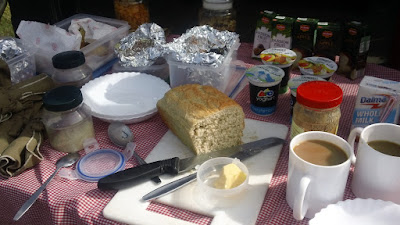Like all things fun, new and exciting, our time in the Kenyan wilderness flew by in what seemed like a nanosecond. It went so fast that Aman and I found ourselves having a serious conversation about the possibility of extending our stay by a night ... oh, the joys of having a flexible travel schedule. Cooler heads prevailed of course, when we got an estimate of what a one-night extension would cost. We also realized that the problem was that we didn't want to leave at all, and prolonging our inevitable departure by one night did not make much sense. Besides, we had accomplished so much during our relatively brief stay... 3 day game drives, 1 night game drive, 1 full-day excursion to the Maasai Mara, 1 walking safari, countless sightings of wildlife in connection with all of the above, and a cultural visit to a Maasai village to boot. Not bad. Here are some photos from our last game drive, which included a spectacular sunrise, a delicious bush breakfast, and brilliant views of a giraffe herd moving gracefully across the distant plains as we ate:
All of this says nothing of our time in camp, and all the fun we had there. Each night was fairly similar. After arriving home from a long day traversing the plains, we and the camp's other guests would congregate in the mess hall. We would gather round the fire on one of the soft over-sized couches and recount the day's adventures, before moving to the dining area for a delicious family-style meal. The camp managers, Roelof and Helen, joined us each night, as did Arthur, the camp's assistant manager. There was also Richard and Craig from the U.K., Jonathan, a British ex-pat living in New York, and Kevin and Greg from Texas. (Sorry guys, I never figured out how to make the font blink... trying my best with colorful bold!)
All of this says nothing of our time in camp, and all the fun we had there. Each night was fairly similar. After arriving home from a long day traversing the plains, we and the camp's other guests would congregate in the mess hall. We would gather round the fire on one of the soft over-sized couches and recount the day's adventures, before moving to the dining area for a delicious family-style meal. The camp managers, Roelof and Helen, joined us each night, as did Arthur, the camp's assistant manager. There was also Richard and Craig from the U.K., Jonathan, a British ex-pat living in New York, and Kevin and Greg from Texas. (Sorry guys, I never figured out how to make the font blink... trying my best with colorful bold!)



























